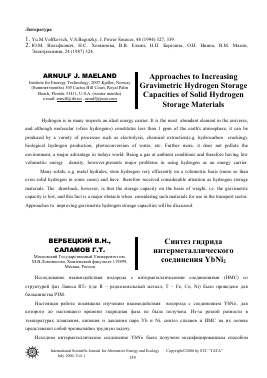Литература
1. Yu.M.Volfkovich, V.S.Bagotzky, J. Power Sources, 48 (1994) 327, 339.
2. Ю.М. Вольфкович, Н.С. Хозяинова, В.В. Елкин, Н.П. Березина, О.И. Ивина, В.М. Мазин, Электрохимия, 24 (1987) 324.
ARNULF J. MAELAND
Institute for Eneregy Technology, 2007-Kjeller, Norway (Summer months) 305 Cactus Hill Court, Royal Palm Beach, Florida 33411, U.S.A. (winter months) e-mail: arnulf@ife.no , arnulf@juno.com
Approaches to Increasing Gravimetric Hydrogen Storage Capacities of Solid Hydrogen Storage Materials
Hydrogen is in many respects an ideal energy carrier. It is the most abundant element in the universe, and although molecular («free hydrogen») constitutes less than 1 ppm of the earth's atmosphere, it can be produced by a variety of processes such as electrolysis, chemical extraction(e.g. hydrocarbon cracking), biological hydrogen production, photoconversion of water, etc. Further more, it does not pollute the environment, a major advantage in todays world. Being a gas at ambient conditions and therefore having low volumetric energy density, however,presents major problems in using hydrogen as an energy carrier.
Many solids, e.g. metal hydrides, store hydrogen very efficiently on a volumetric basis (more so than even solid hydrogen in some cases) and have therefore received considerable attention as hydrogen storage materials. The drawback, however, is that the storage capacity on the basis of weight, i.e. the gravimetric capacity is low, and this fact is a major obstacle when considering such materials for use in the transport sector. Approaches to improving gravimetric hydrogen storage capacities will be discussed.
ВЕРБЕЦКИЙ В.Н., САЛАМОВ Г.Т.
Московский Государственный Университет им. М.В.Ломоносова, Химический факультет 119899, Москва, Россия
Синтез гидрида интерметаллического соединения YbNi2
Исследование взаимодействия водорода с интерметаллическими соединениями (ИМС) со структурой фаз Лавеса ЯТ2 (где Я - редкоземельный металл, Т - Бе, Со, №) было проведено для большинства РЗМ.
Настоящая работа посвящена изучению взаимодействия водорода с соединением УЬ№2, для которого до настоящего времени гидридная фаза не была получена. Из-за резкой разности в температурах плавления, кипения и давления пара УЬ и N1, синтез сплавов и ИМС на их основе представляет собой чрезвычайно трудную задачу.
Исходное интерметаллическое соединение УЬ№2 было получено модифицированным способом
International Scientific Journal for Alternative Energy and Ecology July 2000, Vol. 1 139
Copyright©2000 by STC "TATA"
синтеза в индукционной печи в атмосфере аргона. По данным РФА УЬ№2 кристаллизуется в кубической сингонии (структурный тип ЫеСи2) с периодом решетки а = 7.094 А, что достаточно хорошо согласуется с литературными данными.
В результате оптимального подбора давления и температуры впервые был синтезирован гидрид на основе ИМС УЬ№2. Рентгенографическое исследование показало, что образование гидрида сопровождается увеличением объема элементарной ячейки на 22.5% Работа выполнена при поддержке РФФИ, грант № 99-03-32508.
VERBETSKY V.N., SALAMOV G.T.
Lomonosov Moscow State University, Department of Chemistry, 119899, Moscow, Russia
Synthesis of hydride phase of YbNi2 intermetallic compound
Investigation of interaction of hydrogen with intermetallic compounds of Laves phase structure RT2 (R -rare earth metal, T - Fe, Co, Ni) is already studied for the majority of rare earth metals.
Present work is dedicated to a studying of hydrogen interaction with YbNi2 intermetallic compound, for which hydride phase wasn't obtained earlier. Cause of a large difference of a melting point, boiling point and vapour pressure for Yb and Ni, synthesis of an alloys and intermetallic compounds on its base appears as a very hard problem.
Primary intermetallic compound YbNi2 was obtained by modificated method of synthesis in the induction stove in argon atmosphere. On the basis of X-ray data YbNi2 crystallizes in a cubic structure (type MgCu2) with lattice period a = 7.094 A, which coordinates with a literature data.
As a result of an optimal selection of pressure and temperature a hydride phase was synthesized for the first time on a base of intermetallic compound YbNi2. X-ray diffraction showed, that forming of a hydride accompanying to the increasing of a unit cell for 22.5%.
Present work carried out under supporting of RFFI, grunt № 99-03-32508.
fir$- International Scientific Journal for Alternative Energy and Ecology Copyright©2000 by STC "TATA" July 2000, Vol. 1 140
Для дальнейшего прочтения статьи необходимо приобрести полный текст. Статьи высылаются в формате PDF на указанную при оплате почту. Время доставки составляет менее 10 минут. Стоимость одной статьи — 150 рублей.
